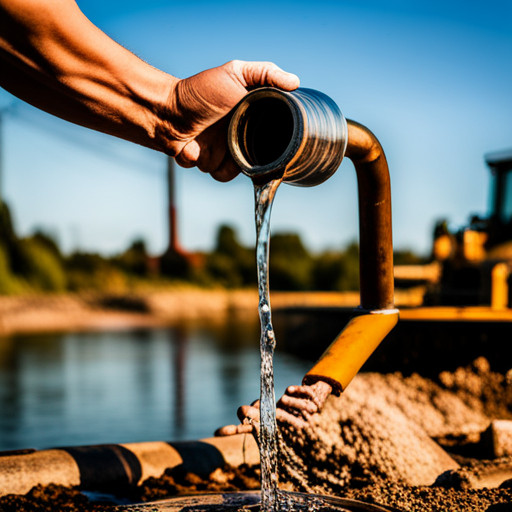Toxic Waters: Understanding the Health Implications of Everyday Exposure
In recent times, the contamination of water resources has become a global concern.

This article explores various sources of water pollution and the associated health risks. It delves into scientific explanations of how pollutants affect human health and discusses preventative measures to reduce exposure.
Furthermore, it proposes effective solutions for cleaner and safer water, thereby contributing to ongoing discussions on this environmental issue.
Key Takeaways
- Point-source and non-point-source pollution from industrial and agricultural activities, as well as inadequate wastewater treatment facilities, are major sources of water contamination and pollutants.
- Contaminated water can lead to various health risks, including diarrheal diseases, cognitive impairment, developmental delays, reproductive issues, and chronic health problems caused by heavy metals.
- Preventative measures such as stringent pollution control regulations, household filtration systems, and awareness about safe water practices are crucial in reducing exposure to toxic waters.
- Effective solutions for cleaner and safer water include comprehensive strategies, pollution legislation, rigorous monitoring systems, household filtration systems, and ongoing research and technological advancements.
Identifying Sources of Water Contamination

Investigating the primary sources of water contamination is integral in understanding its potential impact on public health. This includes pinpointing pollutant origins and identifying contamination symptoms.
Pollutant origins generally fall into two categories: point-source pollution, which can be traced back to a single source such as an industrial discharge pipe; and non-point-source pollution, typically resulting from runoff carrying a mixture of contaminants from various diffuse locations.
Notably, agricultural activities contribute significantly to non-point-source pollution through pesticide and fertilizer runoff that seep into groundwater or flow into surface water systems. Industrial activities also play a significant role in contaminating water supplies with heavy metals, chemicals, and other toxic substances.
In urban areas, inadequate wastewater treatment facilities are common origins of pollutants including harmful bacteria and viruses. Furthermore, natural disasters like floods can exacerbate these issues by disrupting sewage systems and spreading pollutants over wider areas.
Understanding contamination symptoms is a crucial aspect of assessing the severity of water pollution problems. These symptoms may manifest in several ways depending on the type and concentration of contaminant involved. For instance, bio-contaminants such as bacteria or viruses might cause gastrointestinal illnesses or more serious diseases like cholera or typhoid fever upon ingestion.
Chemical contaminants often present different symptoms including skin irritation when used for washing or cooking; long-term exposure can result in chronic health conditions such as liver damage or cancer.
Overall, identifying pollutant origins coupled with recognizing contamination symptoms will provide valuable insights into the extent of public health risks posed by water contamination.
The Science Behind Water Pollutants and Human Health

Comprehension of the scientific principles relating to water contaminants and their impact on human wellbeing is crucial for effective environmental policy making. This comprehension largely revolves around understanding pollutant absorption processes and implementing appropriate health monitoring systems.
Pollutant absorption refers to the process whereby contaminants from polluted water enter the human body, generally via ingestion or skin contact. Various types of pollutants exhibit distinct absorption characteristics, influencing their potential harm to humans. For instance, heavy metals like lead and mercury can accumulate in tissues over time, causing chronic health issues such as kidney damage or neurological disorders.
Health monitoring plays a pivotal role in managing exposure risks. Regular analysis of blood and urine samples can provide valuable data on individual pollutant levels in the body, enabling early detection of potentially harmful accumulation. However, current methods are often reactive rather than proactive; they tend to focus on treating symptoms after exposure has occurred rather than preventing exposure in the first place.
To address this shortfall, recent research efforts seek to develop predictive models that use environmental data to anticipate contamination events before they occur, thus enabling timely intervention measures. Similarly, advances in biosensor technologies are opening up possibilities for real-time health monitoring that could alert individuals to elevated pollutant levels at an early stage.
Common Health Risks Associated With Contaminated Water

Common health risks associated with contaminated water encompass a wide array of ailments, including gastrointestinal disorders, neurological conditions, and reproductive issues. The impact of waterborne contaminants is extensive and complex, often triggering disease outbreaks that can affect entire communities or regions.
According to research conducted by the World Health Organization (WHO), diarrhoeal diseases alone account for an estimated 4% of the total global disease burden and are responsible for the deaths of about 1.8 million individuals annually. The primary cause is consumption of contaminated water laden with microorganisms such as bacteria, viruses or parasites.
Furthermore, neurotoxic contaminant impacts are also prevalent in cases where heavy metals like lead or mercury have infiltrated water sources. Chronic exposure to these elements can result in severe neurological complications such as cognitive impairment and developmental delays in children.
Reproductive issues attributed to water contaminants represent another significant concern. For instance, endocrine-disrupting compounds found in some pesticides could potentially interfere with hormonal balance when ingested through polluted water - leading to fertility problems among both men and women.
To mitigate these health risks effectively, comprehensive strategies should be implemented at both local and international levels. These measures ought to include stringent pollutant control regulations alongside rigorous monitoring systems for early detection of potential disease outbreaks linked to contaminated waters.
Preventative Measures to Reduce Exposure to Toxic Waters

Preventative measures aimed at reducing public interaction with contaminated water sources encompass a wide range of strategies, from implementing stringent pollution controls to raising awareness about safe water practices. These interventions are typically guided by Pollution Legislation that targets the primary sources of contamination.
For example, regulations may be enacted to limit industrial waste discharge into rivers and lakes, or to control agricultural runoff into groundwater systems.
Understanding the extent and nature of such legislation is critical since it directly impacts the quality of water reaching households. However, while these efforts are crucial in mitigating systemic contamination risks, they do not necessarily guarantee safety at the point-of-use due to potential post-source contamination or lapses in treatment processes.
To address this concern, Household Filtration systems have been advocated as an additional layer of protection against exposure to toxic waters. Such filtration units can range from simple activated carbon filters that remove chlorine and organic compounds, to advanced reverse osmosis systems capable of eliminating heavy metals and pathogens.
Research suggests significant health benefits associated with household filtration use; however, these outcomes largely depend on appropriate selection, installation and maintenance practices. There is also a need for increased public education regarding effective uses of these systems as poor understanding often results in misuse or underutilization.
Effective Solutions for Cleaner and Safer Water

Effective solutions for cleaner and safer water encompass a broad range of strategies, including advanced filtration systems, public education on water safety, and stringent pollution control legislation. A detailed scrutiny of these measures reveals nuanced approaches that address both the short-term and long-term challenges associated with maintaining clean water sources.
Water filtration methods are central to this discourse as they provide immediate remediation for contaminated water. These methods vary in complexity from simple charcoal filters to sophisticated nanotechnology-based systems. The choice of filtration method is often dictated by the type and extent of contamination present. For example, while charcoal filters may be sufficient to remove certain organic compounds, heavy metal contamination typically requires more advanced solutions such as reverse osmosis or activated alumina filters.
Sustainable water practices serve a dual purpose: prevention and conservation. They help prevent future pollution through responsible waste management strategies that limit the release of harmful substances into bodies of water. Additionally, sustainable practices preserve existing clean water resources through strategies like rainwater harvesting or wastewater recycling which can significantly reduce demand on natural freshwater reserves.
Public education on water safety is crucial because it equips individuals with knowledge about potential dangers in their local watersheds and encourages responsible behavior that can mitigate risks.
Frequently Asked Questions
What Are the Economic Impacts of Water Contamination and How Does It Affect Local Communities?
Water contamination poses significant economic impacts, affecting local communities through increased healthcare costs, loss of tourism revenue, and expenditure on contamination remedies. Additionally, it necessitates investment in pollution prevention measures to safeguard public health and local economies.
How Does Water Pollution Contribute to Climate Change and Global Warming?
Water pollution exacerbates global warming through increased greenhouse gas emissions, particularly methane. Effective Pollution Solutions and Global Strategies include wastewater management and policies to reduce industrial pollutants that contribute to climate change.
Are There Any Specific Government Policies or Regulations in Place to Combat Water Pollution?
Numerous government policies and regulations, referred to as Pollution Legislation, exist globally to mitigate water pollution. Their Regulatory Effectiveness varies and is often contingent on factors such as enforcement, compliance, and technological advancements.
What Role Do Corporations and Industries Play in Water Pollution and What Responsibility Do They Have in Addressing the Issue?
Corporations and industries significantly contribute to water pollution. Under the principle of corporate accountability, they have a responsibility to implement pollution prevention strategies and reduce their environmental impact in accordance with regulatory guidelines.
Besides Human Health, How Does Water Contamination Impact Local Wildlife and Ecosystems?
Water contamination detrimentally impacts local wildlife, disrupting their adaptation processes. It also compromises ecosystem resilience, leading to biodiversity loss and altered food chains, thus destabilizing the balance of ecological communities.
Conclusion
In conclusion, understanding the sources and health impacts of water contamination is crucial for implementing effective preventative measures.
Comprehensive studies underscore the significant risks posed by toxic waters, thereby stressing the need for cleaner and safer alternatives.
As awareness grows and technological advancements continue, it is hoped that solutions will be found to mitigate these issues, ensuring a healthier future for all.

This post has been generated by AI and was not reviewed by editors. This is Not legal advice. Please consult with an attorney.




